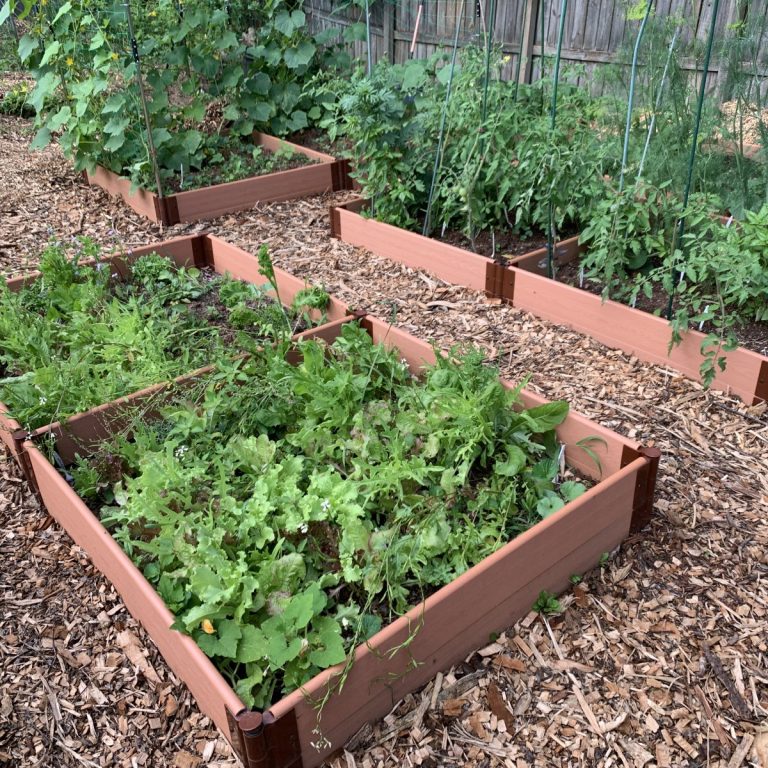When starting a vegetable garden you may not have the best soil to plant in, as is the case with our back yard here in Georgia. Turning poor soil into good soil is an ongoing process, and can take years. We have been composting for some time but the amount produced is not significant enough to dramatically improve the entire garden.
Recently we ordered mulch from a free service called Chip Drop, that connects local arborists, who want a convenient way to drop off wood chips, with people who want free those wood chips (with some caveats which I will mention).
What’s in it for the customer? A large quantity of free organic wood mulch! This is NOT a small amount, but can be a mountain of mulch. I estimate our last load is over 200 wheelbarrows of mulch (but we stopped keeping an accurate count after about 70). We are still moving mulch after over three weeks. Read some of the benefits of wood chips from local arborists, or tree services.
Benefits of Arborist Wood Chips for Mulching
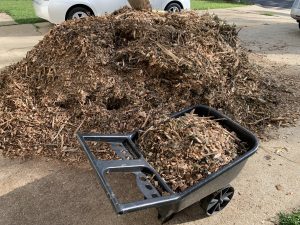
- No chemicals – Wood chips from arborists are organic. They don’t have added chemicals that may be found in store-bought mulches.
- Improvement to soil nutrient level – Although there is minimal nitrogen loss at the surface (see below), wood chips contribute to a net increase in nutrient level.
- Soil moisture is retained – Wood chips as a mulch prevent the soil from drying out as fast.
- Weeds are suppressed or killed – Weeds need sun to grow and as little as several inches of wood chips could significantly reduce weeds. The ones that do get through should be easy to remove.
- Soil temperature is regulated – Wood chips act as an insulator from the heat and cold.
- Garden appearance is improved – Instead of having weeds grow in the garden pathways and having rain pool on top of poor soil, wood chip mulch absorbs the water and makes for great walkways.
- You can usually get them for free! – We calculated a similar load from a mulching service as over $838 for the cheapest mulch, and another $825 for installation. Services like Chip Drop offer free wood chips, and some municipalities have community wood chip locations, where residents can get some for free.
So what’s in it for the arborists? They need to unload wood chips as conveniently as possible, for as little money as possible. Instead of taking a truckload of chips to a landfill or drop point far from their customers they pay $20 to access a local drop point of a person who will take them, leaving them to go quickly to their next project. According to Chip Drop, customers offer to pick up the tab about half the time, and may even offer more than $20. Any sum offered by the customer over the $20 fee to drop does not go to the arborists, but is accrued as credits to future drops, and they can never get actual cash. This means that if the customer contributes $60 the tree-cutting service gets a free drop this time and two other free drops (if the next customer doesn’t offer $20).
What are the previously mentioned caveats? There are several that we found out that you must be aware of before you place a request.
What Should You Know Before Ordering Free Mulch From ChipDrop?
- You may get just a little, or a lot – You have little control over the size of the chip drop. The first load was about 40-50 wheelbarrows of 4.5 cubic feet, but the next one was a mountain of chips that could easily be four times as large. Our friend got an equally large load.
- You may get the order today, or 40 days from now – Wood chips are delivered when there is a need for an arborist to unload and it is convenient for them to do so. This may be the same day, in a week, a month, or longer. You will have to keep a place open for the drop because you may not even get a notice that it is coming, although you likely will on a short notice.
- You may have to consider neighborhood ordinances – Some neighborhoods have strict HOAs that may take issue with a small mountain of mulch in your driveway, so keep this in mind. Your front yard may not look the nicest for a few weeks.
- You may not get exactly what you requested – You may make requests but they aren’t necessarily honored. On the first load we requested no softwood and got exactly this. For the next drop we requested the same but received mostly softwoods, such as fir and pine.
- There are a few health concerns – After only a few days the wood chips start to transform slowly into mulch. This is from fungi such as mushroom mycelium that decompose the wood. While this is good for the wood, breathing the dust may be bad for those with breathing issues, but it is even recommended to wear a mask even if you have not health issues. Also, consider that for a larger drop you may need to be in fairly good health to move quickly.
- You need space to put the wood chips – Once the drop is received you can’t send it back, so prepare for the possibility of the largest load possible, and know where you will put this. I estimate the second drop we received was about 200 wheelbarrows of 4.5 cubic feet, or about 1,600 scoop shovels of material.
- There may be some logs and trash – You may get some smaller logs or stumps in the drop. We didn’t in two drops, but our friend got a small tree stump. Also keep in mind that some trash may end up in the pile, although it is usually not much.
- Wood chips need time to compost – Also keep in mind that you won’t have nice soil for some months, or even the next year. In a large pile parts of the wood start breaking down in a few days but for the whole load to break down it will be some time.
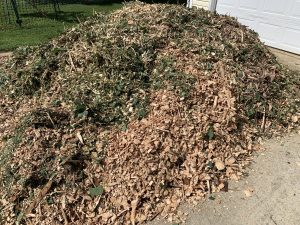
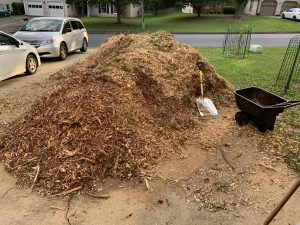
What To Keep in Mind When Adding Wood Chips to the Vegetable Garden?
There are some concerns about soil nitrogen depletion from high-carbon mulches such as wood chips affecting plant growth. There is some nitrogen depletion on the surface of the soil but this should not be very deep. There are conflicting opinions on how much plants are affected by high-carbon material, but vegetables shouldn’t be significantly affected because of this if the wood chips are not too deep, especially plants with deeper roots. You can add green matter such as grass clippings to provide the nitrogen content as well. You should never bury the wood chips where your vegetables grow as this removes nitrogen from deep in the soil. In general, when fully composted wood chips return the nitrogen and many more nutrients to the soil.
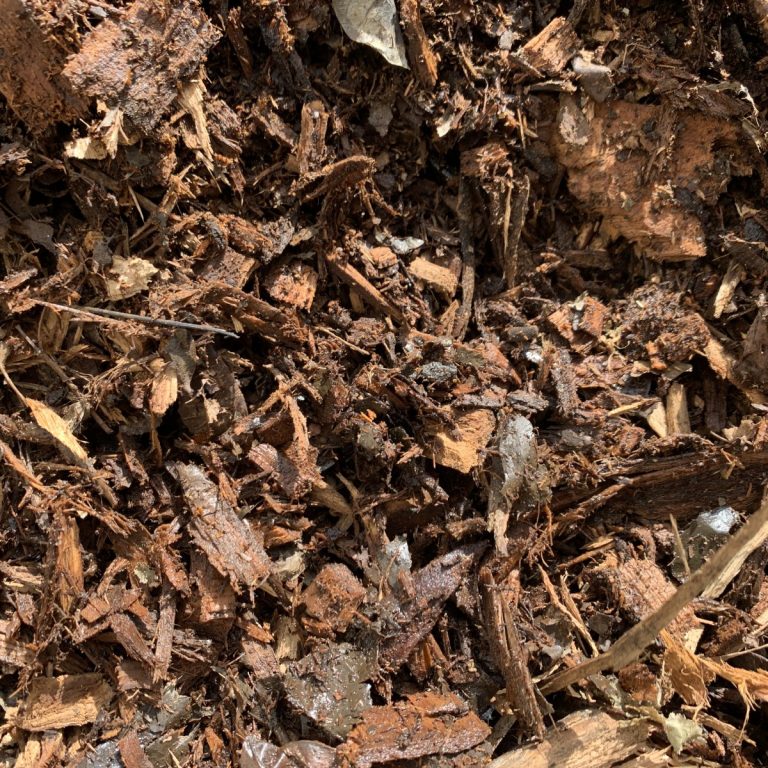
Another consideration is that wood chips take time to decompose, although you can speed this up a bit. For something to compost you need brown, carbon-rich material, such as dry leaves or wood chips. You also need green, nitrogen-rich material, such a grass clippings, kitchen compost, or livestock manure. When these are together in the proper proportion the decomposition is sped up. With arborist wood chips you get a good amount of leaves and pine straw, which helps, but it can still take months to over a year to fully decompose into soil.
Overall, I would highly recommend using this service if you are looking to improve they quality of your soil. It’s totally free, and just requires time. Organic wood chips overall greatly improve the quality of your soil and the appearance of your garden. Happy gardening!

